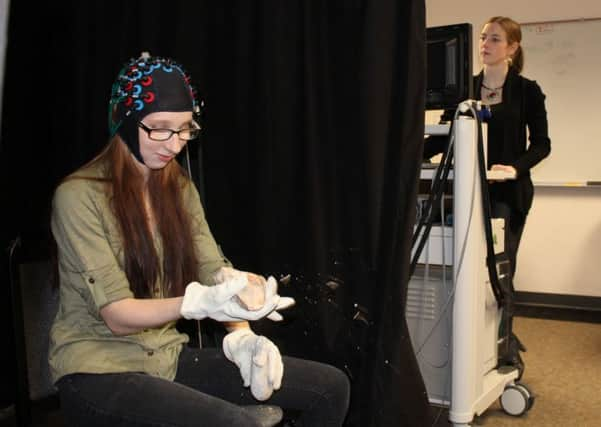Stone-age men were first '˜pianists', say experts


Stone-age people who invented two-sided weapons such as hand-axes and cleavers were activating the same brain circuits as those used for playing the piano rock and roll-style, a study has shown.
The switch from simple flake and pebble technology to more sophisticated tools, 1.75m years ago, is considered an important step in human evolution.
Advertisement
Hide AdAdvertisement
Hide AdBritish and American scientists have now published the results of brain scans on modern-day volunteers who were recruited to simulate the production of prehistoric tools.
They found that the manufacture of so-called “Acheulian” artefacts required a combination of visual memory, hearing, movement awareness and action-planning - all essential ingredients of being a musician.
Professor John Spencer, from the University of East Anglia, said: “Our findings do not neatly overlap with prior claims that language and stone tool production co-evolved. There is more support for the idea that working memory and auditory-visual integration networks laid the foundation for advances in stone tool-making.
“It is fascinating that these same brain networks today allow modern humans to perform such behaviours as skilfully playing a musical instrument.”
Advertisement
Hide AdAdvertisement
Hide AdPeople living 1.75m years ago had not yet developed any kind of sophisticated language, so the evolution of language circuits in the brain is not thought to have helped them upgrade to Acheulian tools.
The study, published in the journal Nature Human Behaviour, used an advanced form of brain scan called functional near-infrared spectroscopy to track the volunteers’ neural activity in real time.
Fifteen of the 31 participants learned to knap stone by watching videos, accompanied by verbal instruction. The other 16 acquired the skill using the same videos, but with the sound turned off.
The study leader, Dr Shelby Putt, from the Stone Age Institute in the American city of Indianapolis, said: “This work offers novel insights into prehistoric cognition using a cutting-edge neuro-imaging technique that allows people to engage in complex actions while we are measuring localised brain activity.
Advertisement
Hide AdAdvertisement
Hide Ad“The study reveals key brain networks that might underlie the shift towards more human-like intelligence around 1.75m years ago.
“We think this marked a turning point in the evolution of the human brain, leading to the evolution of a new species of human.”
US co-author Professor Robert Franciscus, from the University of Iowa, said the evolution of modern intelligent humans remained a “great mystery”.
He added: “We discovered that the appearance of a type of more complexly shaped stone tool kit in the archaeological record marked an important cognitive shift when our ancestors started to think and act more like humans rather than apes.”
Advertisement
Hide AdAdvertisement
Hide AdIn Yorkshire, two-sided Palaeolithic tools have been uncovered during mineral extraction at Cantley and Rossington, near Doncaster.
The previous generation of prehistoric “Oldowan” tools are up to 2.5m years old and represent the earliest evidence of cultural behaviour.